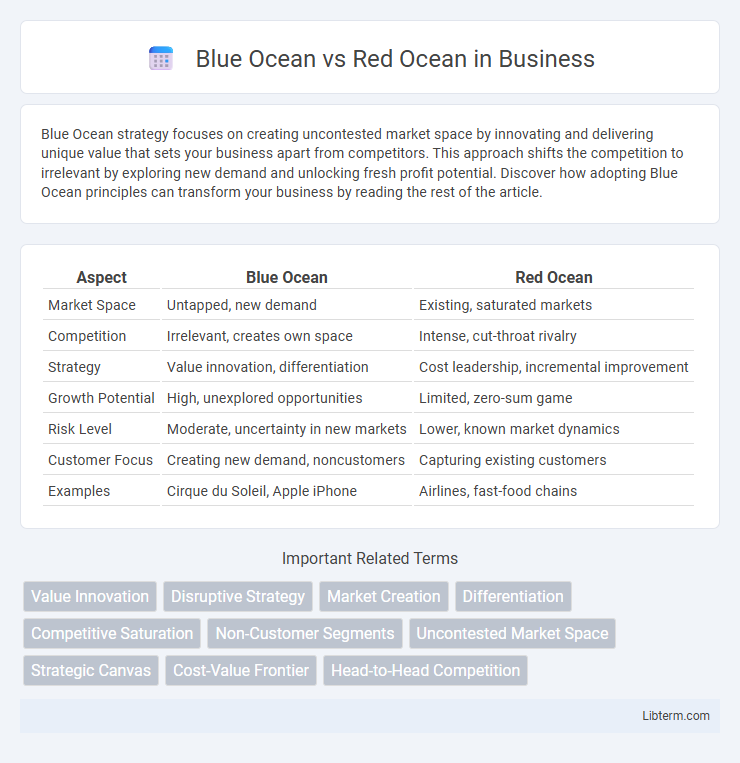Blue Ocean strategy focuses on creating uncontested market space by innovating and delivering unique value that sets your business apart from competitors. This approach shifts the competition to irrelevant by exploring new demand and unlocking fresh profit potential. Discover how adopting Blue Ocean principles can transform your business by reading the rest of the article.
Table of Comparison
| Aspect | Blue Ocean | Red Ocean |
|---|---|---|
| Market Space | Untapped, new demand | Existing, saturated markets |
| Competition | Irrelevant, creates own space | Intense, cut-throat rivalry |
| Strategy | Value innovation, differentiation | Cost leadership, incremental improvement |
| Growth Potential | High, unexplored opportunities | Limited, zero-sum game |
| Risk Level | Moderate, uncertainty in new markets | Lower, known market dynamics |
| Customer Focus | Creating new demand, noncustomers | Capturing existing customers |
| Examples | Cirque du Soleil, Apple iPhone | Airlines, fast-food chains |
Understanding Blue Ocean and Red Ocean Strategies
Blue Ocean Strategy emphasizes creating uncontested market space by innovating value and making competition irrelevant, while Red Ocean Strategy focuses on competing within existing industries by outperforming rivals to capture a larger share of saturated markets. Companies employing Blue Ocean approaches seek differentiation and low cost simultaneously through value innovation, leading to new demand and growth opportunities. Red Ocean strategies involve exploiting existing demand and beating competition, often resulting in fierce rivalry and limited profit margins.
Key Differences Between Blue Ocean and Red Ocean
Blue Ocean strategies focus on creating uncontested market space by introducing innovative products or services, while Red Ocean strategies compete within existing markets by outperforming rivals. Blue Ocean emphasizes value innovation to make competition irrelevant, targeting untapped customer needs, whereas Red Ocean centers on exploiting existing demand and competitive positioning. The key difference lies in Blue Ocean's pursuit of differentiation and low cost simultaneously, contrasting with Red Ocean's trade-off between these factors in saturated markets.
Advantages of Blue Ocean Strategy
The Blue Ocean Strategy offers significant advantages by creating uncontested market space, enabling companies to innovate without direct competition pressure. This approach drives higher growth potential and profitability through value innovation, appealing to untapped customer segments. Firms adopting Blue Ocean Strategy often achieve sustainable competitive advantage by differentiating their offerings and reducing cost-based rivalry.
Challenges of Navigating Red Oceans
Navigating red oceans involves intense competition where businesses fight for limited market share, leading to saturated markets and shrinking profit margins. Companies face challenges such as price wars, commoditization of products, and high customer acquisition costs. Strategic differentiation and constant innovation are critical to survive in these fiercely contested and overcrowded industries.
Value Innovation: The Core of Blue Ocean Strategy
Value innovation lies at the heart of Blue Ocean Strategy, driving the creation of uncontested market space by simultaneously pursuing differentiation and low cost. Unlike Red Ocean strategies that focus on beating competition in existing markets, value innovation breaks trade-offs between value and cost, delivering exceptional value to customers while reducing expenses. This strategic approach enables companies to unlock new demand and render competition irrelevant by redefining industry boundaries and offering unique products or services.
Case Studies: Successful Blue Ocean Shifts
Apple's launch of the iPhone exemplifies a successful Blue Ocean shift by creating an uncontested market space blending phone, music, and internet functionalities, surpassing traditional mobile competitors. Cirque du Soleil redefined live entertainment by merging circus arts with theater, attracting a new audience and avoiding the saturated traditional circus industry. Tesla's innovation in electric vehicles opened a blue ocean by combining luxury, performance, and sustainability, differentiating itself from conventional automakers focused on internal combustion engines.
Competitive Factors in Red Ocean Markets
Red Ocean markets are characterized by intense competition where businesses strive to outperform rivals through pricing, product features, and market share. Firms engage in aggressive strategies targeting existing demand, often leading to saturated markets with shrinking profit margins. Key competitive factors include cost efficiency, differentiation, and operational excellence to maintain relevance in crowded industries.
Steps to Create a Blue Ocean
To create a Blue Ocean, start by identifying uncontested market spaces where competition is irrelevant, focusing on innovation that delivers unique value to customers. Apply the Four Actions Framework--eliminate, reduce, raise, and create factors--to reconstruct market boundaries and break away from the red ocean of cutthroat competition. Develop a compelling value proposition by aligning innovation with utility, price, and cost positions to attract new demand and make the competition obsolete.
Transitioning from Red Ocean to Blue Ocean
Transitioning from Red Ocean to Blue Ocean requires shifting focus from competing in saturated markets to creating uncontested market space through innovation and value creation. Businesses must identify underserved customer needs, redefine industry boundaries, and develop unique offerings that make competition irrelevant. Emphasizing differentiation and cost leadership enables firms to unlock new demand and achieve sustainable growth.
Future Trends in Ocean Strategies
Future trends in ocean strategies emphasize the blending of Blue Ocean and Red Ocean approaches through digital transformation, artificial intelligence, and sustainability. Companies increasingly leverage big data analytics and innovative technologies to create uncontested market spaces while simultaneously optimizing existing competitive markets. Emphasis on eco-friendly initiatives and circular economy models drives the shift, positioning strategic innovation as key to navigating both emerging opportunities and competitive landscapes.
Blue Ocean Infographic

 libterm.com
libterm.com